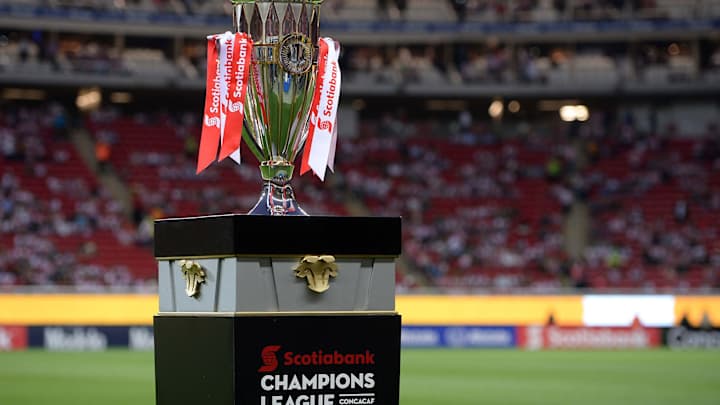The Future of the Concacaf Champions League–for 2020 and Beyond

Concacaf is targeting mid-to-late December to finish its 2020 Champions League tournament, which was paused during the quarterfinal round in March because of the coronavirus pandemic. The regional governing body intends to stage the competition at a single site, most likely in the southern U.S., while reducing the two-leg matchups to a single game when possible, Sports Illustrated understands.
Four MLS clubs—Atlanta United, Montreal Impact, New York City FC and Los Angeles FC—remain in contention. Montreal’s TSN 690 radio was the first to report Concacaf’s plan.
Concacaf will be following UEFA’s lead. The Europeans successfully concluded their postponed Champions League tournament in Lisbon, Portugal, in August, with Bayern Munich claiming its sixth title with a victory over Paris Saint-Germain in the final.
The key difference between UEFA’s plan and Concacaf’s is the resolution of home-and-home series that were halfway done. In Europe, the second leg was played in August behind closed doors at the originally scheduled host’s stadium. In Concacaf, the opener has been played in three of the four quarterfinals. However, it appears the second game of those series will be played at the selected neutral site. The fourth quarterfinal series between LAFC and Cruz Azul never kicked off, so it will be decided by a single match at the neutral site.
TSN 690 reported California, Texas, Florida and Mexico as potential CCL sites. Sports Illustrated understands that Mexico remains a possibility but a U.S. location is the most likely scenario. NYCFC is trailing Mexico's Tigres UANL, 1-0 on aggregate, and now will avoid having to settle the series in Monterrey. Montreal is trailing Honduras's Olimpia, 2-1 on aggregate, and will miss out on a trip to San Pedro Sula. Atlanta is behind, 3-0 on aggregate, to Club América and was to host the second leg.
Both semifinals and then the final will be a single game, meaning the entire event will comprise seven games played across three rounds. It could be accomplished in about a week.
MLS clubs have captured the Concacaf championship only twice, and both wins occurred when the event was contested as a single-elimination tournament on American soil. D.C. United was triumphant in 1998, and the LA Galaxy won two years later. December’s revised format offers a better chance at the title, plus an asterisk, to the four MLS sides still in contention.
There’s an opening in the calendar thanks to the inevitable postponement of the FIFA Club World Cup, which was supposed to be played in mid-December in Qatar. The seven-team field won’t be filled by then. The Copa Libertadores just resumed recently and now isn’t scheduled to be finished until the end of January. The Asian champion won’t be crowned until Dec. 19, and Oceania postponed its OFC Champions League indefinitely.
The MLS Cup final is scheduled for Dec. 12.
December’s audible will represent just the beginning of a potential overhaul of Concacaf’s top club tournament over the next 2-3 years. Although the knockout-only format has been regarded by many as an improvement over the frequently dull group stage games contested in 2008-16, there appears to be a sense among Concacaf officials that the 16-team bracket implemented in 2018 is too exclusive and too short. It lacks the season-long footprint of its counterparts on other continents and features a reduced number of games between MLS and Liga MX sides. As a result, it now faces potential competition from the Leagues Cup launched independently by those two leagues.
Concacaf president Victor Montagliani said during a virtual Soccerex event last month that a new format ideally would be in place for the 2022-23 season.
“I think the [CCL] is the next asset we are looking at to grow,” he said. “If you compare it to other confederations, we don’t play the same amount of games. So it’s about more games more often and giving opportunities to clubs we all resonate with in our own domestic leagues to play at another level.
“Our Champions League will grow and increase and will likely start post-2022 after the World Cup,” he continued. “We are already in contact with our stakeholders to ensure how that looks, and we’re in a position to make an announcement sometime next year in regards to our new enhanced and robust Champions League for fans to see those rivalries more often.”
Concacaf is aware of the pitfalls of the CCL’s group stage and isn’t eager to revisit them. Games frequently were lopsided, especially for Mexican clubs, while MLS teams had difficulty marketing mid-week matches against foreign sides with which many fans were unfamiliar. The four-team groups eventually shrank to three, but the games still failed to generate much buzz. So the groups were abandoned.
Ways to expand the tournament while skipping an initial group stage would be to simply tack on a round-of-32 to the existing bracket, thereby doubling the number of teams (preliminary rounds could be added for smaller clubs), or by conducting a group stage later in the competition. Until 2016 in Africa, for example, CAF staged knockout rounds until eight teams remained. Then those eight played in two, four-team groups. (It has since doubled the number of groups to four.) These two potential solutions are speculation. Concacaf hasn’t decided on a competition system, just on an expansion. It’s unknown how many more MLS and Liga MX teams will qualify under an expanded format.
The fate of the Concacaf League, a bracketed CCL qualifier that features teams from Central America and the Caribbean, plus the Canadian Premier League champion, also is unknown. Some kind of qualifying competition could remain in place, or it could be folded into the larger CCL.

A lifelong soccer player, coach and fan, Brian Straus joined SI in 2013 after covering the sport for The Washington Post, AOL and Sporting News.